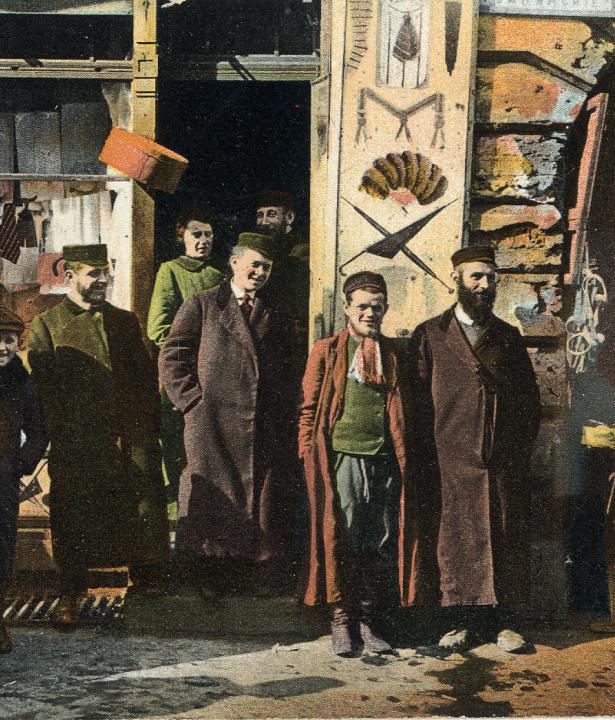Over the past two centuries, discussions about Copernicus have played a key role in German-Polish relations. The years commemorating the anniversaries of the astronomer’s birth and death crystallized the debates.
Text
The foundations for the competing national commemorative cultures were laid back in the first half of the 19th century, when Poles and Germans discovered Copernicus as a central figure in their respective cultural heritages. The first wave of Copernicus memorials was erected. Generally speaking, they were used to make a claim for Copernicus being exclusively a part of German or Polish history. The research into Copernicus’ life, his ecclesiastical offices, and astronomical teaching, which took place in parallel, was also more or less strongly shaped by national viewpoints. Furthermore, the Copernicus biographies produced by German secondary school teacher Leopold Prowe and Polish science historian Ludwik Antoni Birkenmajer, which were published towards the end of the 19th century, represent studies that are still seen as definitive works on the 16th century scholar.

Leopold Prowe laid the groundwork for modern research into Copernicus with his Copernicus biography published in 1883/84. CC BY-SA 4.0
Leopold Prowe laid the groundwork for modern research into Copernicus with his Copernicus biography published in 1883/84. CC BY-SA 4.0
Text
According to cultural theorist Elisabeth Ritter, the start of the Second World War saw “the discussions around Copernicus reach their peak.”1 In 1939, Nazi Germany celebrated the apparent Germanness of the astronomer with Kant-Copernicus Week in Königsberg. Popular novels also located Copernicus in “einem deutschen Osten” – literally a “German east”, referring to German-speaking areas in Eastern Europe. By contrast, the resistance to the German national reinterpretation of Polish Copernicus memorials became something of great symbolic importance to the Polish population. On May 24, 1943, a gala took place in New York’s Carnegie Hall to mark the 400th anniversary of Copernicus’ death. It was organized by a Polish foundation and was envisaged as an act of solidarity with occupied Poland. Immediately after the end of the Second World War, the newly founded Polish university in the town of Copernicus’ birth, Toruń, was named after him. 1953 was named Copernicus Year by the incumbent Communist party, to make up for the Polish memorial celebrations which had failed to take place in 1943 due to the Second World War.

Extract from the 1973 mural by Stefan Knapp in the auditorium of the Nicolaus Copernicus University in Toruń. Pko, Wikimedia Commons, CC BY-SA 4.0
Extract from the 1973 mural by Stefan Knapp in the auditorium of the Nicolaus Copernicus University in Toruń. Pko, Wikimedia Commons, CC BY-SA 4.0
Text
When it comes to the more recent history of how Copernicus has been received, 1973 was a key year: UNESCO declared it an international commemorative year to mark the 500th anniversary of Copernicus’ birth. This international anniversary included lots of different events and campaigns: “From Chicago to Tokyo, from Santiago in Chile to Kolkata, people marked the life of Copernicus with festivities, congresses, and exhibitions, films, coins, and stamps,”2 as noted in a review at the end of the Copernicus Year. It marked the beginning of long-term projects and academic careers in science: Owen Gingerich, who is now considered to be one of the top experts on Copernicus, says that in the early 1970s, and inspired by the upcoming anniversary year, he went from being a young astrophysicist to a historian of astronomy.
Text
Conflicting interpretations of the historical figure of Copernicus were still abounding in the 1973 anniversary year. It is particularly evident when we consider the different celebrations that took place in West Germany, East Germany, and in Poland. Both the national interpretative frameworks passed on from the 19th century and the ideological battles between East and West played a role here. Yet there were also opportunities for collaboration between German and Polish scientists, and there were some initial signs of a new interpretation of Copernicus as a “European” and part of “Europe’s heritage.” Nowadays, the naming of the European Union’s Earth Observation Program Copernicus, which is fed by satellite data as well as ground-based measuring stations, is one example demonstrating the success of this interpretative framework. As Elisabeth Ritter noted ironically, Copernicus has been stylized as a “Super-European.”3
Text
English translation: LEaF Translations








